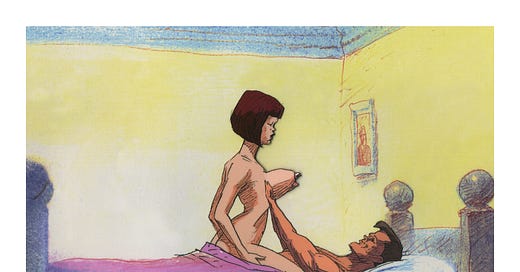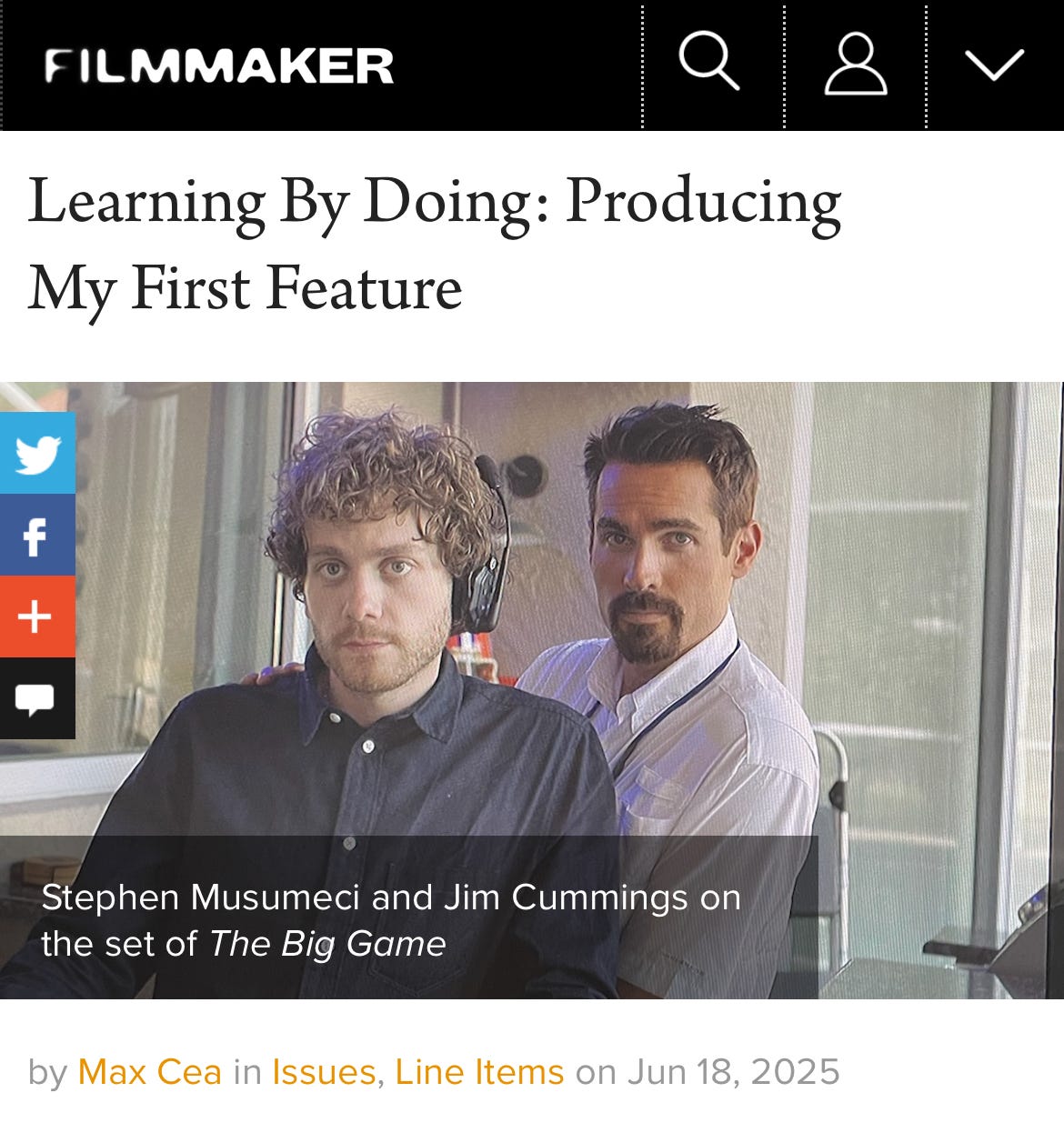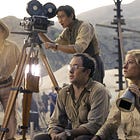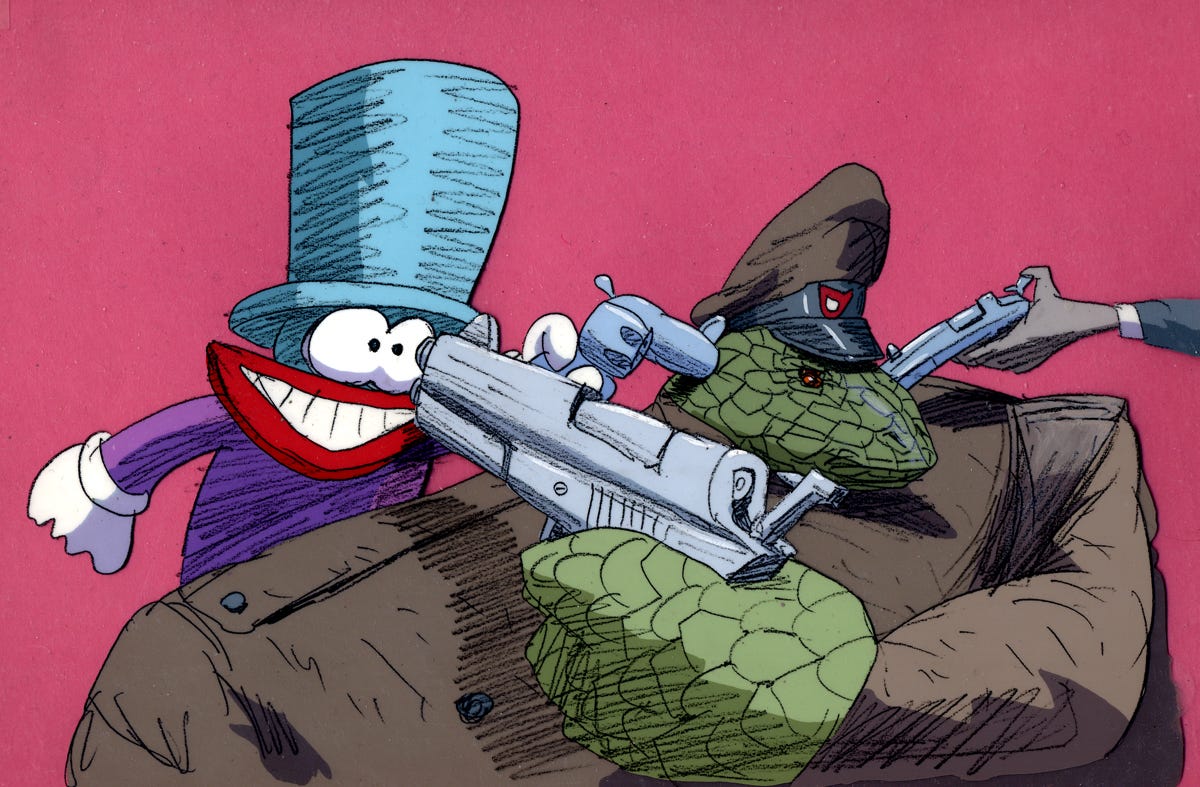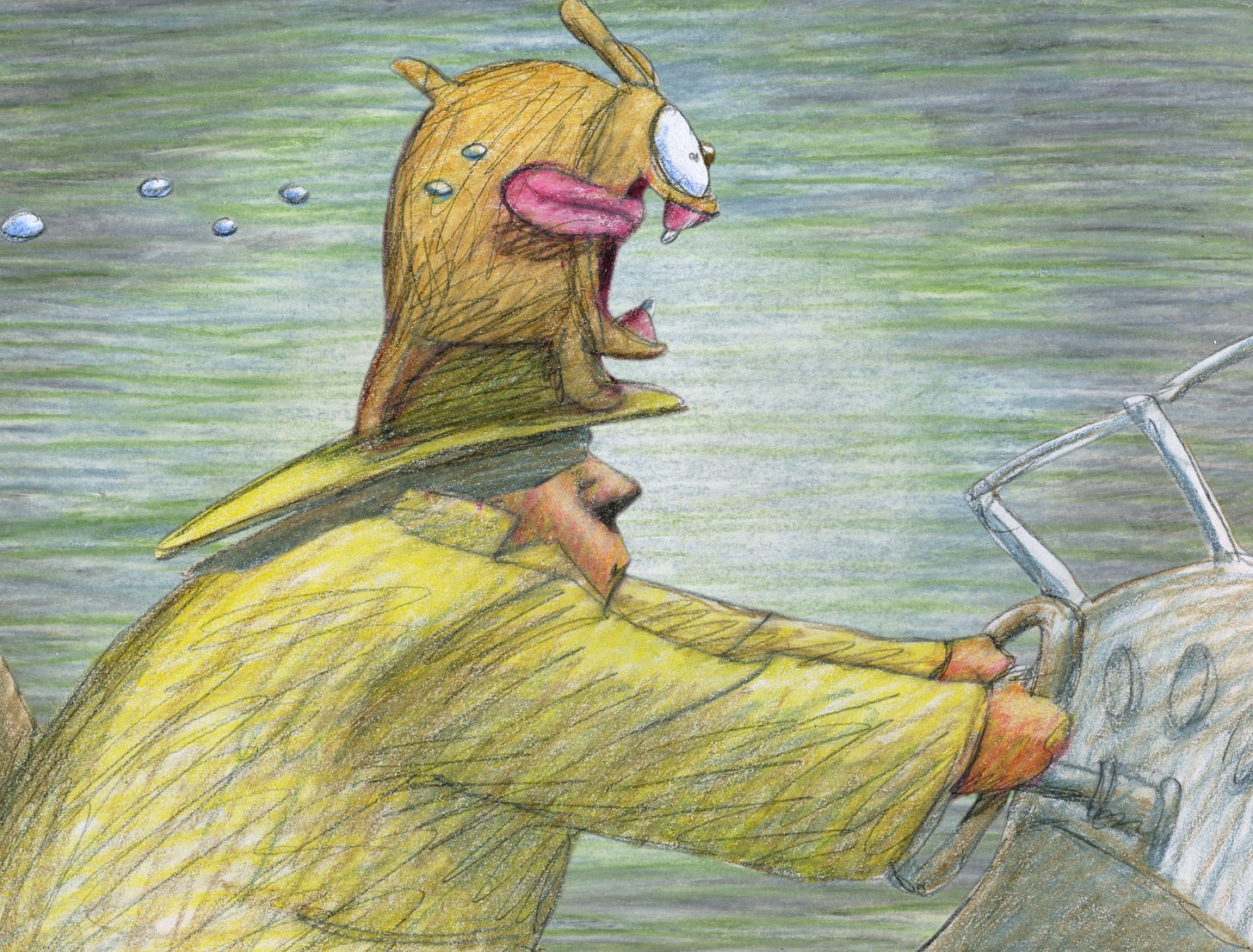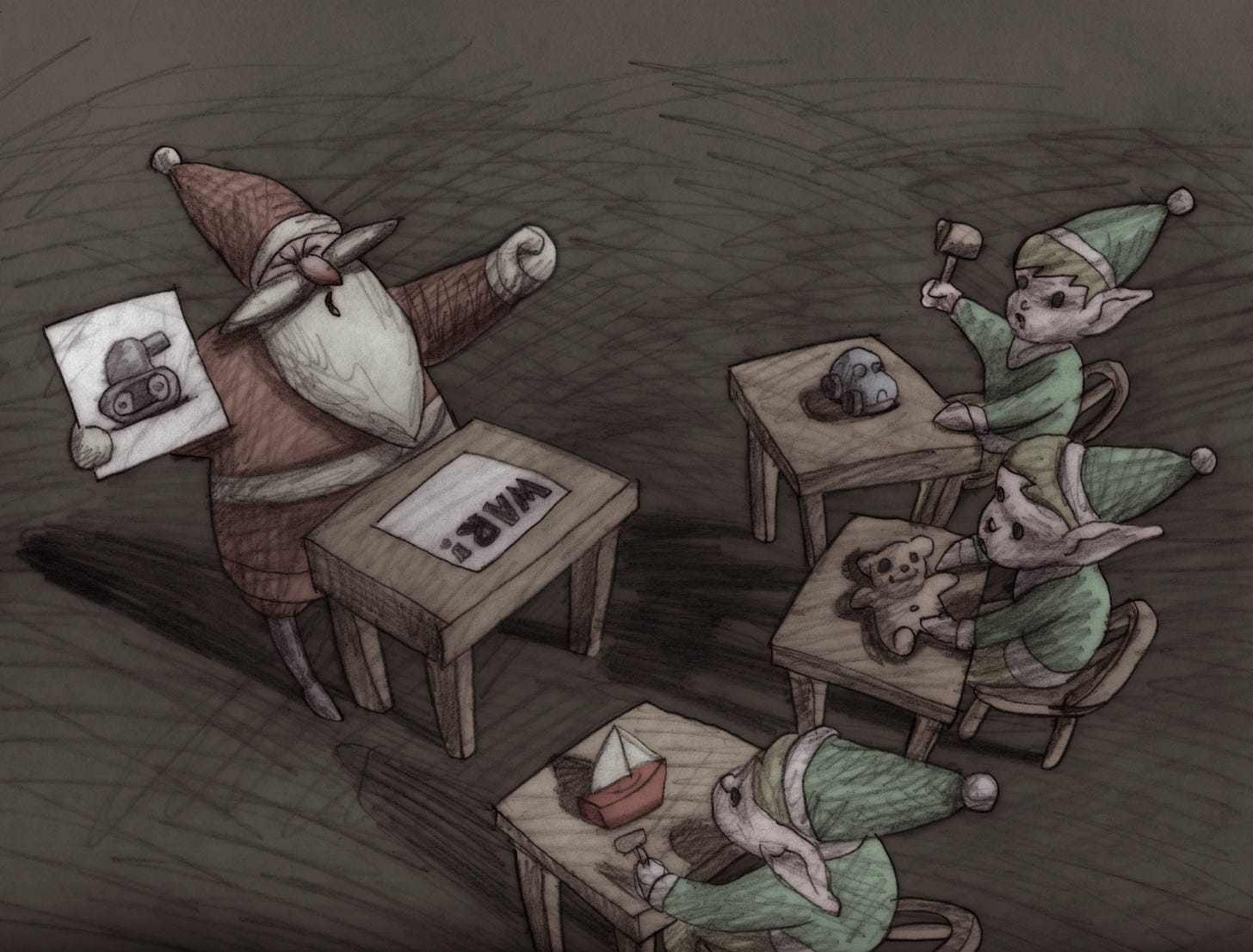Bill Plympton Prefers Funny
The legendary cartoonist talks to comedian Nick Naney about sex, exploding heads, run-ins with Quentin Tarantino, and working with Kanye West.
Exciting news from Nothing Bogus HQ! Things are changin’ round these parts. I’m talkin’ format. We’ve got new segments galore. You will love them. So much, I hope, that you consider taking the $5 you might spend on a single coffee and putting it towards a month’s worth of A+ emails from your favorite newsletter. Every bit of support means a lot, and ultimately it makes this thing possible.
OUTSIDE LINKS
In Filmmaker Magazine
I wrote about my experience producing The Big Game. The article, which is online and will be in print soon, is primarily focused on pre-production. It covers lots of lessons learned through trial and error, including finding financing, casting, and choosing a shoot window.
Here’s how it starts…
At nearly 6:00 a.m. on a Wednesday in late March, the sun began to rise in Tampa, Florida, and Stephen Musumeci called cut on The Big Game’s martini shot. The crew clapped and hugged, and Musumeci, who wrote and directed the feature, gave a short, dizzy speech that was interrupted by a producer pouring a large bucket of water (for lack of Gatorade) on his head…
And here’s some bts of the actual bucket of water being poured on Stephen’s head by fellow producer Ray Knudsen:
For the rest of the article (and this one!), subscribe to Filmmaker. It’s only $12/year, and they do great work.
RESOURCES
If you’re a filmmaker, producer, or crew looking for work or collaborators, check out this post and add your info to the Nothing Bogus Directory.
THE FEATURE ATTRACTION
Bill Plympton Prefers Funny
Bill Plympton, the prolific animator and cartoonist behind I Married a Strange Person, Your Face, and The Tune, chats with comedian Nick Naney about his inspirations, wild stories at Sundance, and making music videos for Kanye West.
by Nick Naney
On June 11, I had the honor and the privilege to sit down with my favorite animator, Bill Plympton, in his studio in midtown Manhattan. I had been a fan of Bill’s work since I was a little kid. His style permeated throughout pop culture in advertisements and the center of the cultural zeitgeist, MTV. Years later, I bonded with my wife over our love of his short film, Your Face, and we played the slowed down version of the song used in that short as our first dance at our wedding, much to the bewilderment of our relatives.
A few weeks ago, I got to see a screening of Bill’s third feature film, I Married A Strange Person, at Metrograph, which is currently hosting many of his films on its streaming platform. And I was lucky enough to be asked to sit down with him for an interview. I tried to draw a parallel between his work and my experiences as a comedian obsessed with the bizarre and the sexual. But it’s questionable if I really succeeded. Either way, he did half jokingly offer me a potential acting gig towards the end of the interview, so it would seem to be a win all around.
Nick Naney: I’m kind of an amateur at this. I’m a comedian myself, and I'm interested in the absurd and things of a sexual nature, so to speak. And I'm wondering, growing up, did you have a fascination with these things?
Bill Plympton: Not really. Only when I got into college did I really get into that sort of outrageous surreal stuff. I grew up in the Oregon countryside, in a very all American kind of family, six kids. And I just wanted to draw. That was my thing. I just love to draw every day. I would draw a lot. I watched Walt Disney cartoons, Bugs Bunny and stuff like that.
And then I got into college in '68, when things were getting weird – you know, the whole sexual revolution and crazy art and things like that. And that's when I got really excited about [all of that]. I ran into a bunch of crazy artists at Portland State and I just got influenced by that whole revolution, the whole art and porn and everything. And so that's when I started doing weird drawings. [Laughs.] I was pretty normal in general. I became really weird.
My stand-up, it's got a loud sexual nature. I feel like I sort of play a character on stage that wouldn't be out of place in one of your cartoons.
Sounds like it. [Laughs.]
Something that I grappled with coming up and finding my voice was my family just being sort of disgusted by it. And I'm curious what your experience with that was?
No, my parents weren't disgusted. They were supportive. They would buy me pencils and paper and drawing boards and things like that. However, when I started doing these really sexual drawings — and in my films, too, I had a lot of over the top sexuality — they were really worried that I was not going to make a living doing this. Because they came from the Depression and World War II. They were the perfect generation. And so they were concerned that I wouldn't have money. And I understand that, but I said, “No, I want to be an artist.” And so what happened was we were on vacation and we had a TV on in their hotel room and one of my commercials came on, the Geico commercial. And they said “You did that Geico commercial?” And then they realized, ”OK, you made it.”
At Metrograph, when you intro’d I Married a Strange Person, you mentioned how it sort of came about in a time when adult animation wasn't the lucrative industry that it is now. And I'm wondering how you view the explosion of adult animation now? Because it's obvious how your influence is pretty vast.
Yeah. Well, actually, I don't think it's really fully accepted by distributors. I still have a problem saying, “Well, I'm making a cartoon, but it's not for kids.” They're really hesitant to deal with that. But you see so many live action films that are really raunchy. I mean, There’s Something About Mary or The Hangover are filled with totally outrageous naked stuff. And they still won't accept it in animation now. They're still very afraid of that. And I wish that they would realize there’s a huge audience out there for something like this. But animation's always been stereotyped as being for kids. Since Disney was such a big success, they thought, ”Well, yeah this stuff’s just for kids.” But I think that's slowly changing. We’re pretty close.
I think so, yeah. I was a kid in the early ‘90s. And things like Liquid Television or Ren & Stimpy were where I really connected with cartoons. In the ‘90s, those shows were pretty geared towards kids, but obviously there was like a sexual subtext. And on Liquid Television there was a lot more stuff geared towards people in their twenties. What was your experience like working on Liquid Television?
It was wonderful. I showed the film in Annecy. Have you heard about Annecy?
No.
It's the largest animation festival in the world. It's in France, a beautiful medieval town with a lake and the Swiss Alps and everything. And it's where all the distributors go to buy animated films. All the best films are there. So I was there with Your Face which, as you know, was very well received. And the producers of Liquid Television saw that, and they came up to me and said, “We want to buy it for MTV.” It was Abby Terkuhle. And I said, “Yeah, okay.” And MTV had a lot of money back then. And so I sold, I think, three or four films, maybe more to them. And then I did their station ID, and then I did the MTV Movie Awards animation. So I did a lot of work for them and it was really, really great.
The trouble with MTV was they wouldn’t use my name. I don't know what the reason for that was, because I knew the people who were putting the show together, and they were nice people. And I ran into a couple of animator friends and they said, “Oh yeah, we saw your films on MTV. We didn't know who you were, so we just called you that color pencil guy.” [Laughs.] “It's the color pencil guy! It's the color pencil guy! Come in here. You can see these new cartoons.” So it was kind of a mixed relationship on TV, but it was really exciting just to see myself everywhere. Then that led into doing some music videos. A music video for Madonna, one for Kanye West, Weird Al, people like that. So thanks to MTV I did pretty well.
When you worked on these music videos, what did those collaborations look like?
It was different with each one. The Madonna one, I was just the animator. I wasn't the director. I didn't design the whole project. With Kanye, I got a phone call late one night, “Is this Bill Plympton, the cartoonist?” “Yeah, it's me.” “I need a music video.” Kanye had been working with Michel Gondry for this song, "Heard ‘Em Say,” and he hated the video. I didn't like it either.
But the deal was it had to be on TRL in a week. It was a three minute music video, so it was a lot of work. I did it, even though I wasn't a big fan of Kanye or his music. But I really got to like him. He was a really friendly guy, and he came to my studio, and told me, “I think I look more handsome than that, make me more handsome.” So he was definitely involved in it. He liked my black and white animation, you know, pencil and stuff, and wanted that, and thank God, because I only had a week to do this thing. I was working night and day. He loved it. But all the money for the video was gone. Michel Gondry got all the money, so Kanye paid me a good sum out of his pocket. Plus, he did a gallery exhibition of my art for his music video. And I did a book with him of his songs and his music. So I have good memories of Kanye.
And then with Weird Al, he doesn't have much money. which surprised me. I thought he'd have a big budget. But he said, “Do whatever the hell you want, just go crazy.” Each artist has a different way of working.
Everywhere you go nowadays, we're hearing about AI and seeing it all over the place and it's entering the film industry in all sorts of ways. I’m curious about your take on that.
Well, I don't particularly want to do it. I like my style. I like mistakes, I like smudges, I like eraser marks and rips, even. I'll keep a rip in a drawing if it's nice. So I don't really have a need for AI, but I don't mind it. For now, it doesn't bother me because I'm doing the films the way I want to do them, and the budgets are low. It's not expensive. So maybe in the future that'll change, but so far, I have no problem.
I feel like a lot of creative people that I'm talking to, they have a negative outlook of the future of entertainment because of AI. Do you feel that way as well?
Nope. I'm always positive. Certainly some things have not gone as well as I hoped. But as long as I can make my films and people like them, that stuff doesn't bother me. I've read somewhere this guy said that with AI, he could make an animated feature film in three hours. Just using AI. And I suppose there are people that do that. But it wouldn't have my sick humor.
What are you working on currently?
I'm just finishing up this short film about a whale who can't communicate. And then I just finished the music video for a really nice song by Jon Bellion. And then I'm starting my new feature, which I don't have a name for, but it's much low budget. Very simple. It's like a Jacques Tati film, just weird things happen, and you kind of watch it. So it's kind of milder, not so outrageous.
Would you consider Jacques Tati a major influence?
Definitely
I was watching Idiots and Angels, and I loved how in a lot of your work there’s not really dialogue, and it’s mostly grunting.
[Laughs.] Keep it to an absolute minimum.
Yeah, very much like Tati. Who else would you consider a major influence?
Well, there's a lot of them. Certainly Walt Disney, Tex Avery, Bob Clampett, Winsor McCay. Charles Addams, because his humor was very dark and violent, bloody, and this was in the '30s when you weren't supposed to do that. Milton Glaser, R. Crumb. Roland Topor, Goya, So, yeah, there's a lot of them. I could go on.
Are there any newer people you've seen coming up in the cartoon world that you like?
I love the work of Peter de Seve, who's an illustrator, but he's just a master illustrator. I love Gary Larson. I read his cartoons to my son all the time.
Have you ever done a live action film?
I have, I've done three of them and they were complete flops. I did one that I think is pretty good about Hitler. Hitler’s Folly. And it's sort of an alternate universe where instead of becoming a dictator, he becomes a cartoonist, because he really loved to draw. He went to art school and he really wanted to be an artist. And in this alternate universe he actually does become a cartoonist, and he tries to become the Walt Disney of Germany. And of course, they're terrible films. They're awful and full of propaganda and violence and everything. But that film I thought was really good. That's a good film.
And what would you say are the limitations of live action directing? Like certainly less control of the visual style or performance styles.
Yeah, actors don't like having their heads chopped off.
No. [Laughs.]
Yeah it’s a real downer on their careers. With animation, you can do anything. There's only one rule in animation: don't bore the audience. You’ve got to get something up there that's interesting. It may not be funny, but it should be interesting. But I prefer funny. So for me, that's the secret.
And it’s also interesting to have sexual things on the screen
Yeah. I Married a Strange Person is very influenced by Japanese porno animation. And then another one was Cheatin’. And those are two of my favorite films. I’ll tell you a story about Strange Person, which was probably the most successful animated feature I did.. I think it came out in1999 or '98, something like that. And it got into Sundance, which was great. And so I was really hopeful that, you know, I'd get picked up by Weinstein or someone like that. The audience loved the film. They were applauding and standing, and everybody wanted to meet me, and everybody wanted my autograph and everything, so I thought, “Oh, yeah, we got it locked.” And then no one bought it. No one was interested in the film. And so I was taking the bus there. You've been to Sundance, right?
No, I haven't.
They have shuttle buses that go around to each theater. So I got on the bus to go back to my hotel. And I saw the guy from Lion’s Gate Films. He was there. And I knew him. I met him at a party. So I went up to him. I said, “Hey, how you doing? Having a good time at Sundance?” He said, “Yeah, yeah.” I said, “Well, I got a film here. I don’t know if you knew that or not. It's an animated feature. It's called I Married a Strange Person. I happen to have a DVD of it. Would you like it?” He said, “Nope. I just can't. I've got a stack of films this high in my hotel room. No way I'll be able to see it.” And I was real bummed about that, so I kind of turned around and started walking away, and this snowboarder jumps on the bus, he's got this knit cap with the strings coming down, snow is coming off his face, and his jacket was dripping snow all over my shoes and my pants. He looks at me and he says, "Damn, you're Bill Plympton! Wow. I Married a Strange Person rocked! That's the fucking best film in the festival!”
[Laughs.] Oh, wow.
Then he turns around and jumps off the bus and goes down the hill, and he's gone.
Oh, he just snowboarded right out of the bus?
Yeah! And so the guy from Lions Gate looks at me and says, “Well, maybe I should see your film.” And he saw it, and he loved it. And they paid me a really good chunk of money for it.
That's great.
And then another story from Sundance. Robert Redford has these luncheons for all the directors. No producers, no actors, no photographers, just the directors. So I went there and I met a lot of people. It was really nice. And this nerdy guy comes up to me. "You're Bill Plympton! Oh, my God, I've seen everything. I love Your Face. How did you do that? Who'd you model that after? Was that color pencil or watercolor? What was that?” And then he’s just talking nonstop and he knows all my films. And I said, “Well, geez, you really know me. Who are you?” And he goes, “Oh, I'm Quentin Tarantino. I made Reservoir Dogs." And that's the last I saw of him at the festival. We had fun. We took pictures and everything. But, boy, when that film [Reservoir Dogs] showed, he couldn't be by himself. It really changed his life.
Quentin Tarantino’s a cool fan to have!
A little bit of trivia: If you’ve ever seen Kill Bill, in the beginning of the film, Uma Thurman's getting married in that little church on the roadside. She’s marrying “Mr. Plympton.”
Named after you!?
He put me in. Of course, I get shot after about three seconds. [Laughs.]
He didn't approach you about animating one of the segments?
We talked about it, but he loves this studio in Japan. Real Japanese animation. And quite frankly, they did a really good job.
Yeah although I would have loved to see a Plympton version of that scene.
I've run into him at a lot of festivals. I should ask him, “Do you have any scripts that aren't being produced? Would you want to try animation?”
When you're building a feature, you have a team that that you're directing. How long is that entire process?
Well, for this new film I'm doing now, the Tati film, it'll probably be two years, maybe two and a half years, unless I get some big job like a music video for somebody. Two and a half years. I do every drawing. And I can do that in about a year, year and a half. And then people like [my studio manager] Bianca will do the coloring or the scanning.
Is there still a big scene of animators here in New York?
No, it's not that big. The schools are really popular. You got RISD, you got Parsons, you got SVA, you got Pratt. And they’re training a lot of great animators, but unfortunately, they all want to move out to L.A. because that's where the money is, and I don't blame them.
But New York inspires me because there's so many cartoon people around. People that just show me things I haven't even thought of before. “Why didn't I have that idea?” Yeah, really, creative.
Yeah, unfortunately [moving to LA] is the deal for me right now. But it’s hard to leave this city because there is so much inspiration out here. Just walking around and seeing all sorts of different characters on the street that can inform your work. Anyway, did you ever find out who that snowboarder was?
No. No, never found out. I wish I did. I should hire some actor to play that snowboarder when I introduce my films. I could hire you next time to come to Sundance.
[Laughs.] Yeah, I’ll snowboard onto the stage.
Yeah. Well, I got to get back to work.
OK. Well, this was a real pleasure.
Nick Naney is a comedian and actor who can be seen on HBO’s Fantasmas, The Tonight Show and Office Hours with Tim Heidecker. He has a stand-up special on YouTube called Nick Naney: Nessun Dorma, give it a watch baby!
Bill Plympton’s films are currently streaming on Metrograph At Home. Follow him at @Plymptoons on Instagram, Facebook, YT, Patreon; and through his website, www.plymptoons.com.


